The Ecommerce Evolution: Ecommerce platforms have significantly evolved, prioritizing user-friendly experiences and facilitating the transition from traditional to online retail for businesses of all sizes.
Enter the Giants: Shopify, Wix, and Squarespace have democratized ecommerce by making online store creation accessible to non-developers, challenging the previous domination of platforms like WooCommerce and Magento.
Market Shifts: The ecommerce market has experienced notable shifts in platform popularity, with Shopify emerging as a leader and new contenders like Amplience and PrestaShop making surprising entries.
Global Sales Boom: The continual growth in ecommerce sales has necessitated innovation within the platform market, driving platforms to offer more integrated solutions covering payments, shipping, and marketing.
Chances are, the ecommerce platform many merchants are using these days is different from the one most used 10 years ago. Ecommerce platform market share has significantly shifted over the years, with new players taking over with much more intuitive experiences.
Once upon a time, you couldn’t build your online store without the help of web developers.
But, in came platforms like Shopify, Wix, and Squarespace to simplify the creation and design of ecommerce websites, democratizing the industry for smaller brands that didn’t want to sell on Etsy anymore.
There were much fewer platforms to choose from back then, too. Now, with so many to choose from, it’s more difficult to pick. Yet, the choices are much better.
Plus, ecommerce sales have grown significantly over these years, driving the need for innovation.
In this post, I’ll highlight the biggest players, their current market share, and how they’ve changed over the years.
Key Players in the Ecommerce Platform Market (According to Me)
If you’ve paid any attention to the ecommerce industry, you’ll recognize the biggest players.
Let’s look at each platform real quick before we look at the leaderboard.
These are the ones I expect to be leading the ecommerce platform market share, based on what I encounter the most in the ecommerce world. Certainly, there will be some surprises.
- Shopify. Serving millions of businesses across 175 countries, this Canadian export has come a long way since its founding in 2006. Striving to be everything you need to create a store, Shopify has built-in tools for payments, shipping, marketing, and more.
- Adobe Commerce (Magento). Targeted toward more technical enterprise-level businesses, Magento is open source and allows for endless customizations but doesn’t include all the bells and whistles of Shopify.
- WooCommerce. This open-source platform built on WordPress used to be the king of ecommerce platforms but has fallen down the ranks in recent years. Although less technical than Magento, WooCommerce still requires development resources and allows a ton of customization.
- BigCommerce. Another big player with enterprise brands, BigCommerce has robust built-in features, enables multichannel selling, and simplifies the work of store design (similar to Shopify). Keeping its eye firmly on the higher market brands, its market share continues to a low simmer.
- Wix. While better known for website building, Wix also offers ecommerce capabilities with their integrated online store. It provides easy drag-and-drop store creation, but more limited functionality compared to dedicated ecommerce platforms.
- Squarespace. Similar to Wix, Squarespace is a website builder that includes ecommerce functionality. It offers stylish templates and integrated online selling tools, appealing to smaller businesses and creatives.
These are, in my mind, the biggest cloud-based ecommerce platforms in the world.
And, when I look at the tech behind the ecommerce sites I shop at, I usually see these platforms in there.
Top Ecommerce Platforms By Global Market Share
OK, now that you’ve been formally introduced to the supposed top players in ecommerce platforms, let’s move on to the leaderboard.
I’ve put together the following list with the help of BuiltWith, which tracks the usage of ecommerce platforms (amongst many other things).
They track market share in several ways, but on the top level, they do it by the top trafficked sites on the internet.
More specifically, the top million, top 100k, and top 10k sites on the web. Of those that use ecommerce software, the market share is revealed.
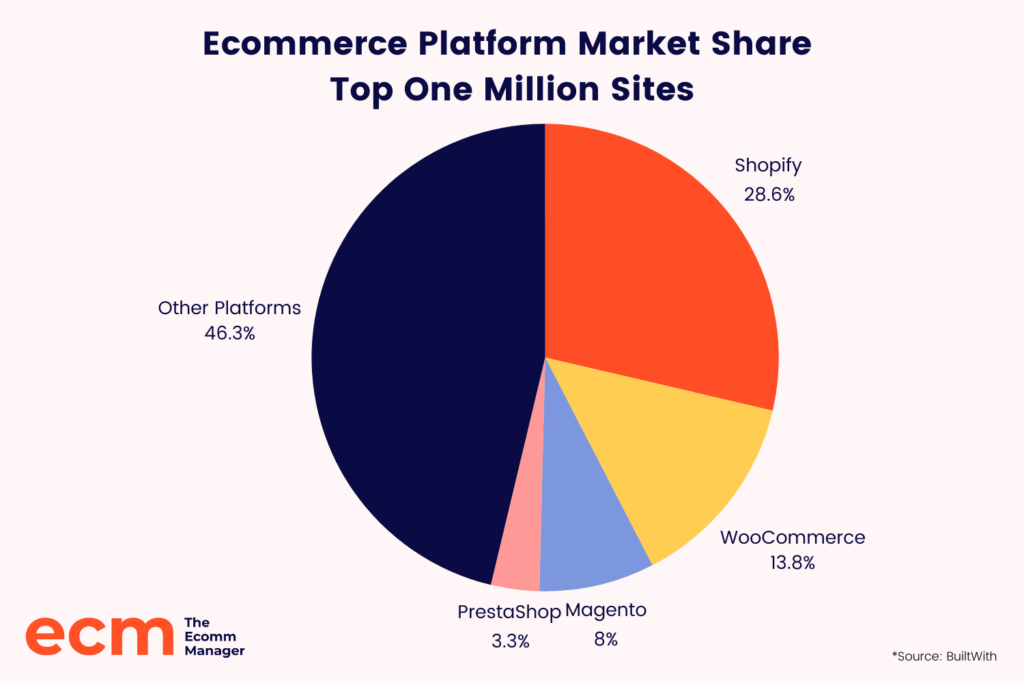


So, that’s the high level, but let’s give some air to each platform separately.
Shopify
We’ll talk about this more later on, but Shopify has only risen to the top spot very recently.
Their flight to the top is a result of their deep focus on covering every aspect of the ecommerce experience, so merchants have all they need to build and launch their online businesses.
BuiltWith separates Shopify from Shopify Plus, so for our purposes, we’ve joined them together again to find this giant’s true numbers.
Currently, Shopify is topping the (pie) charts for ecommerce platform market share:
- Top one million sites: 28.6%
- Top 100k sites: 25.7%
- Top 10k sites: 24.3%
- Top countries using Shopify: United States, United Kingdom, Australia, Brazil, Germany, and Canada
Shopify keeps its commanding share of the market even as you get to the more elite parts of the web.
WooCommerce
Once the reigning champion of ecomm platforms, WooCommerce has lost its footing in recent years, unable to withstand Shopify’s rapid growth.
Nonetheless, they still hold a significant percentage of the market.
- Top one million sites: 13.8%
- Top 100k sites: 9.8%
- Top 10k sites: 5.2%
- Top countries using WooCommerce: United States, United Kingdom, India, Australia, Russia, Italy, and Canada
One thing that stands out is how much the platform slips from the top 100k to 10k trafficked sites.
Where many enterprise brands like the customizability of an open source platform, they are instead moving toward a more powerful solution like Adobe.
Whereas the SMBs that WooCommerce used to serve are moving to Shopify for a less technical experience.
Adobe Commerce (Magento)
Even before Adobe bought Magento, it was a top platform for enterprise brands.
Not for the less technical of heart amongst us, it’s always been a powerful platform for complex stores that wanted total customizability.
Since its acquisition, it’s only gotten more features.
While they can’t seem to shake the name Magento (no matter how much they try), they still find themselves amongst the most used platforms in the world.
- Top one million sites: 8%
- Top 100k sites: 7.7%
- Top 10k sites: 6.7%
- Top countries using Adobe Commerce: United States, United Kingdom, Netherlands, Germany, Italy, Brazil, and France
As I said, WooCommerce likely lost its share of enterprise brands to the more steady and powerful Magento. Seeing their steady market share seems to confirm this for me.
Amplience
This one was a real surprise to me, as I hadn’t heard of Amplience before. Despite that, they’ve skyrocketed to the number two spot for the top 10k sites.
This digital content management and experience platform supports merchants in creating, managing, and delivering personalized content across multiple channels.
It's really the standout winner in the headless commerce space.
See how their market share shifts as you narrow down on the top sliver of sites:
- Top one million sites: 1.77%
- Top 100k sites: 6.7%
- Top 10k sites: 11.1%
- Top countries using Amplience: United States, United Kingdom, Australia, Germany, Netherlands, Canada, and France
One slight hiccup with this reporting is that while Amplience is a headless commerce solution, they aren’t supplying the ecommerce backend, which may well be something like Salesforce Commerce Cloud or Adobe Commerce.
Nevertheless, they’ve earned their spot here.
Prestashop
Here’s another surprise entry for me. I’ve heard of Prestashop before, but it was never one of the top choices in my mind.
PrestaShop is apparently a popular choice for ecommerce businesses, especially in Europe, due to its open-source nature and flexibility.
This platform allows merchants to fully customize their online stores, offering a wide range of modules and themes to suit various business needs.
Despite fierce competition from platforms like Shopify and WooCommerce, PrestaShop maintains a presence in the market:
- Top one million sites: 3.3%
- Top 100k sites: 1.43%
- Top 10k sites: >1%
- Top countries using Prestashop: United States, France, Spain, Italy, Poland, Czech Republic, and Germany
PrestaShop's market share shows its stronghold in regions where merchants appreciate its customizable and scalable solutions.
While it sees a decline in usage among the top 10k sites, it remains a strong contender for small to medium-sized businesses looking for a robust, flexible ecommerce solution.
Other Platforms
Making up roughly half of the market is all the other platforms.
This includes three of the platforms I assumed would make it to the pie chart—BigCommerce, Squarespace, and Wix.
Yet, they barely cracked 1% of the market. Other also-ran platforms I should mention (some of which even beat out those three) are:
- OpenCart
- Demandware
- AbleCommerce
- Salesforce Commerce Cloud
- AVADA Commerce
- Webflow Ecommerce
- SAP Commerce Cloud
- Ecwid
- Mirakl
And, it just goes on and on. There are SO MANY PLATFORMS.
Yet, my assumption of top ecommerce platforms could be shaded by where I’m from. Being in the US, I’m always hearing about Squarespace and Wix.
Let’s see how that all shakes out regionally. It could save my initial supposition.
Ecommerce Platform Market Share By Country
So, showing global numbers only tells part of the story.
Certain platforms will find dominance in certain regions based on a variety of factors—language, platform marketing, technological preferences, regulations, etc.
To zoom in on the question of market share more closely, let’s take a look at how these platforms do in some of the top countries for ecommerce.
USA
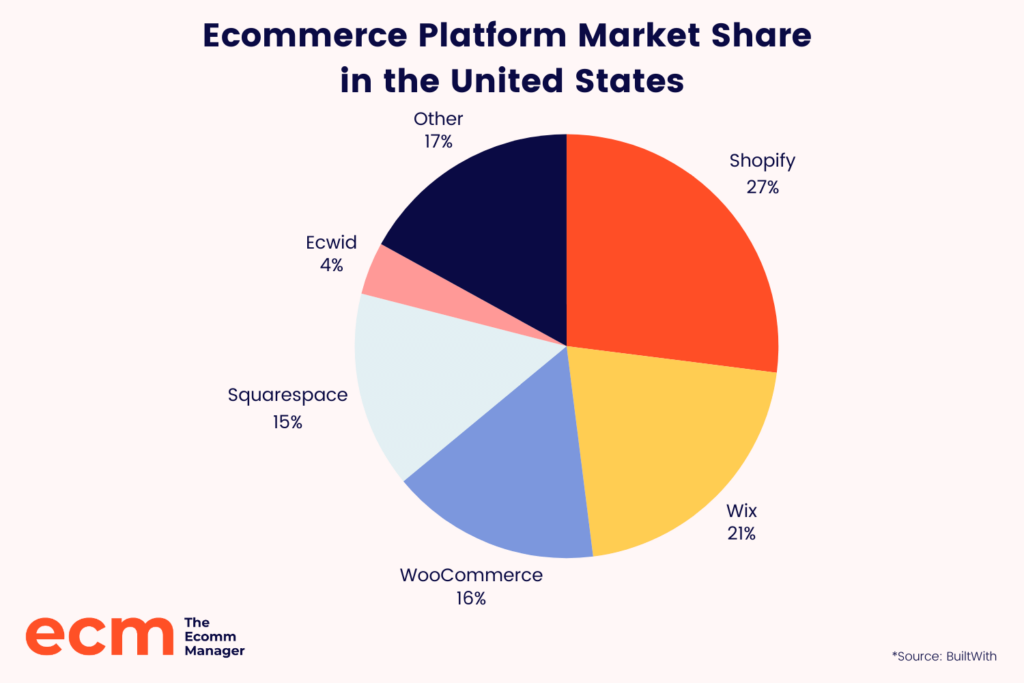
| Platform | Market Share (%) |
| Shopify | 27% |
| Wix | 21% |
| WooCommerce | 16% |
| Squarespace | 15% |
| Ecwid | 4% |
| Other | 17% |
UK
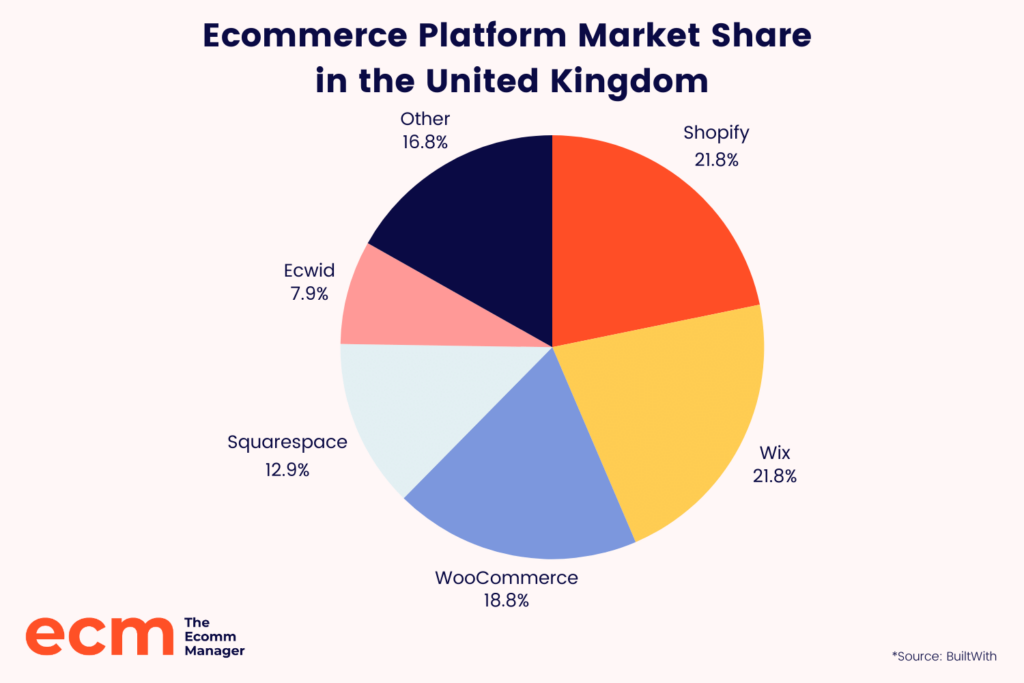
| Platform | Market Share (%) |
| Shopify | 22% |
| Wix | 22% |
| WooCommerce | 19% |
| Squarespace | 13% |
| Ecwid | 8% |
| Other | 17% |
Australia
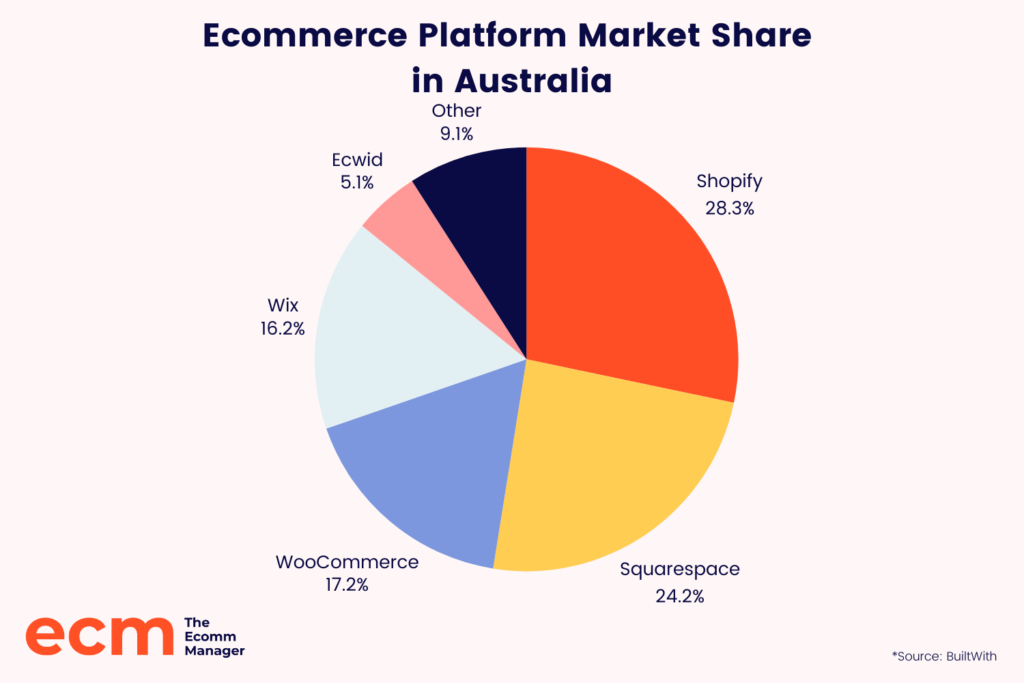
| Platform | Market Share (%) |
| Shopify | 28% |
| Squarespace | 24% |
| WooCommerce | 17% |
| Wix | 16% |
| Ecwid | 5% |
| Other | 9% |
Germany
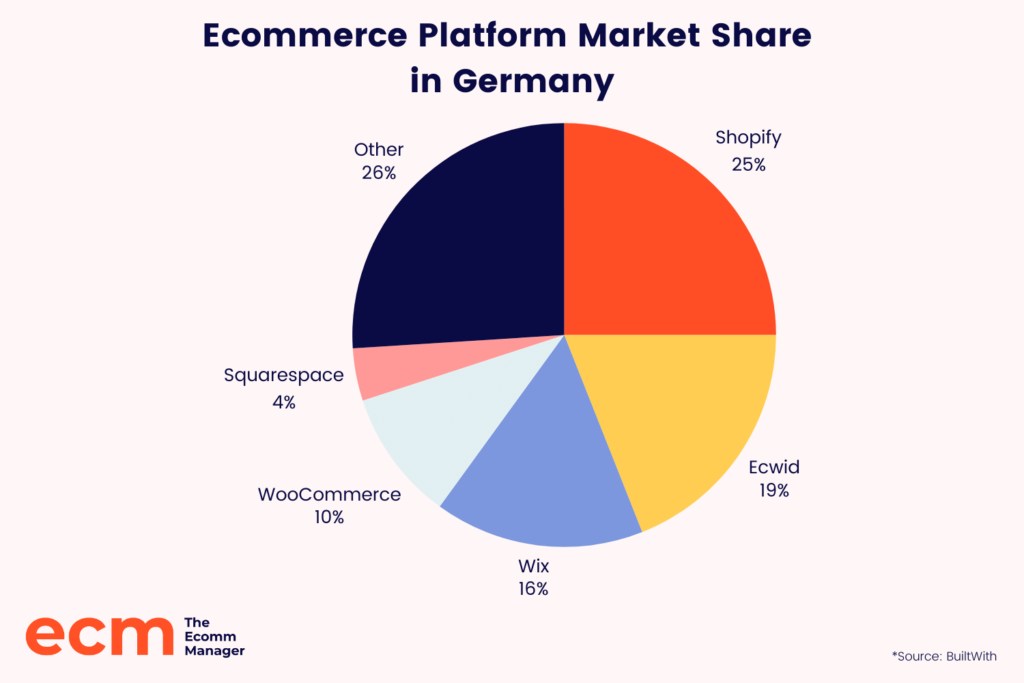
| Platform | Market Share (%) |
| Shopify | 25% |
| Ecwid | 19% |
| Wix | 16% |
| WooCommerce | 10% |
| Squarespace | 4% |
| Other | 26% |
Brazil
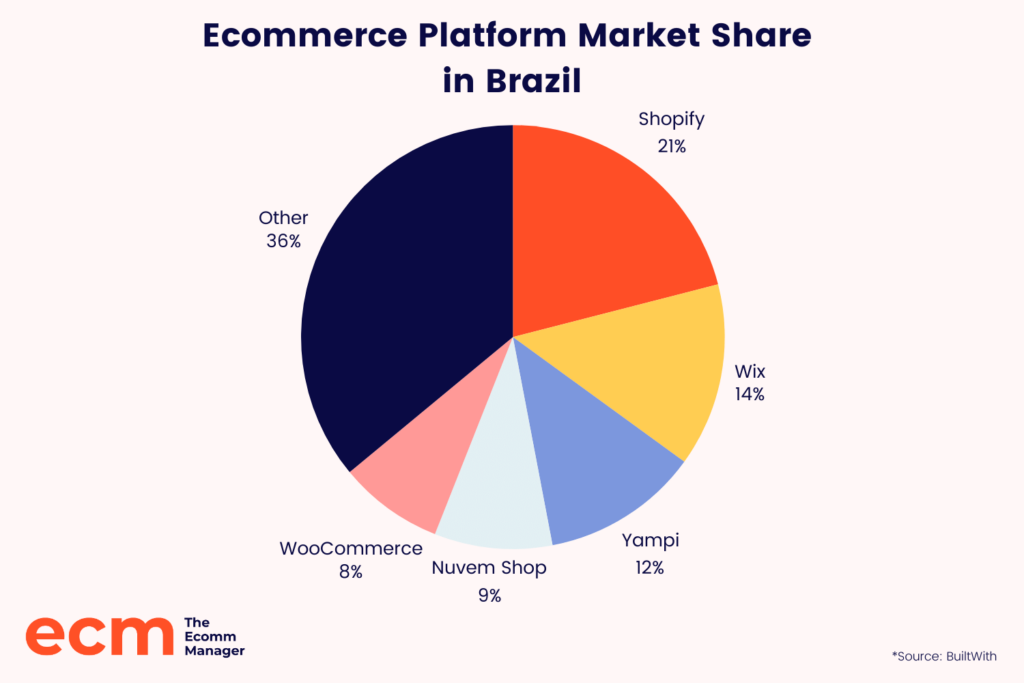
| Platform | Market Share (%) |
| Shopify | 21% |
| Wix | 14% |
| Yampi | 12% |
| Nuvem Shop | 9% |
| WooCommerce | 8% |
| Other | 36% |
Canada
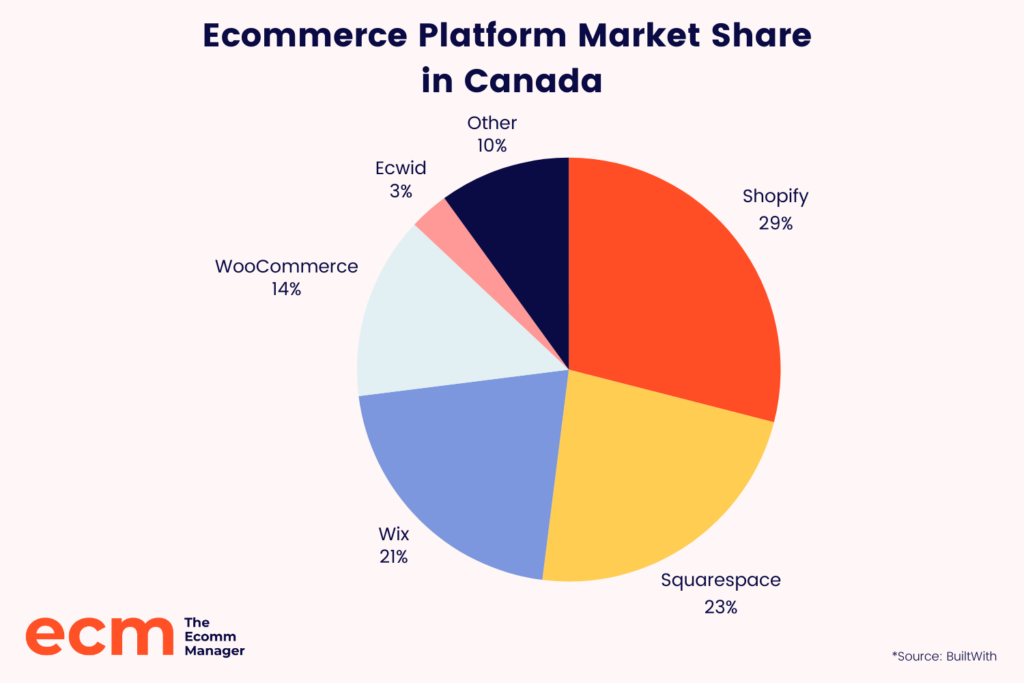
| Platform | Market Share (%) |
| Shopify | 29% |
| Squarespace | 23% |
| Wix | 21% |
| WooCommerce | 14% |
| Ecwid | 3% |
| Other | 10% |
France
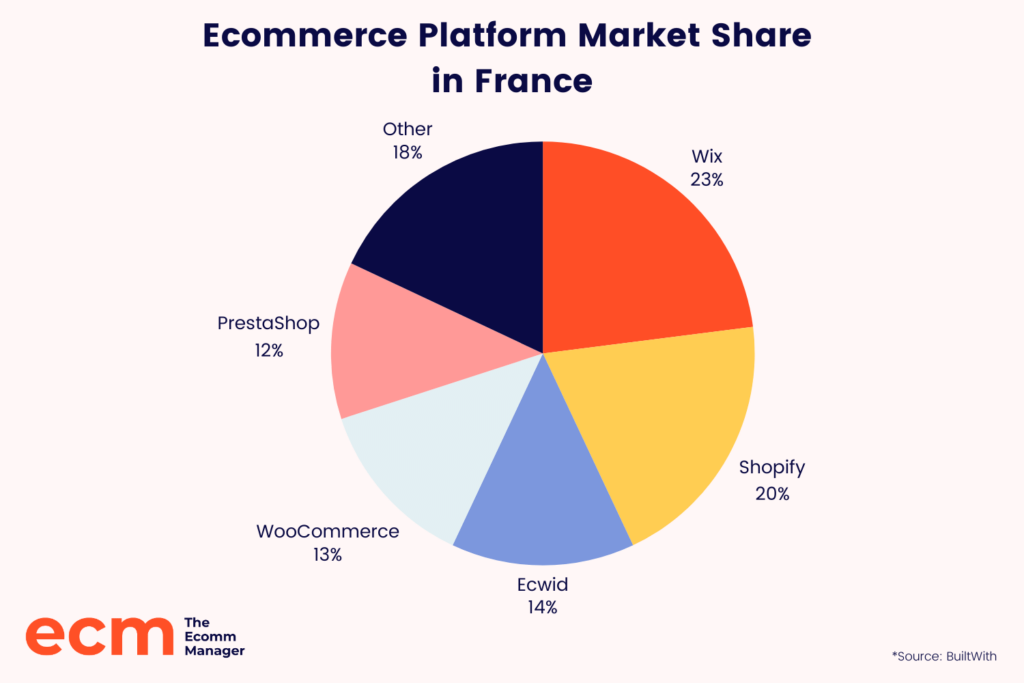
| Platform | Market Share (%) |
| Wix | 23% |
| Shopify | 20% |
| Ecwid | 14% |
| WooCommerce | 13% |
| PrestaShop | 12% |
| Other | 18% |
India
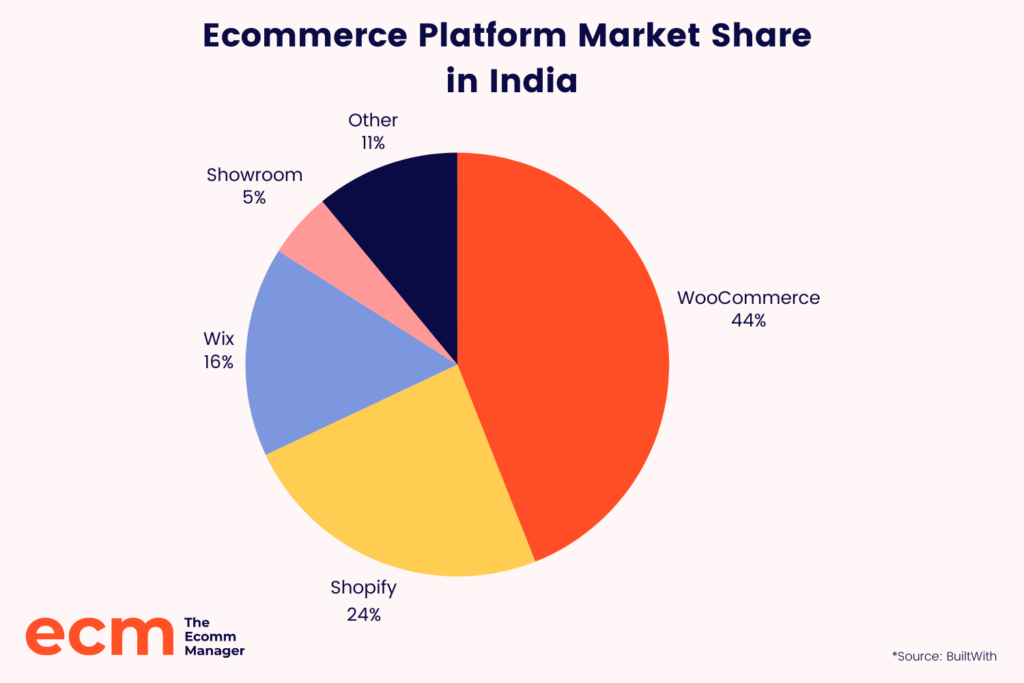
| Platform | Market Share (%) |
| WooCommerce | 44% |
| Shopify | 24% |
| Wix | 16% |
| Showroom | 5% |
| Other | 11% |
Italy
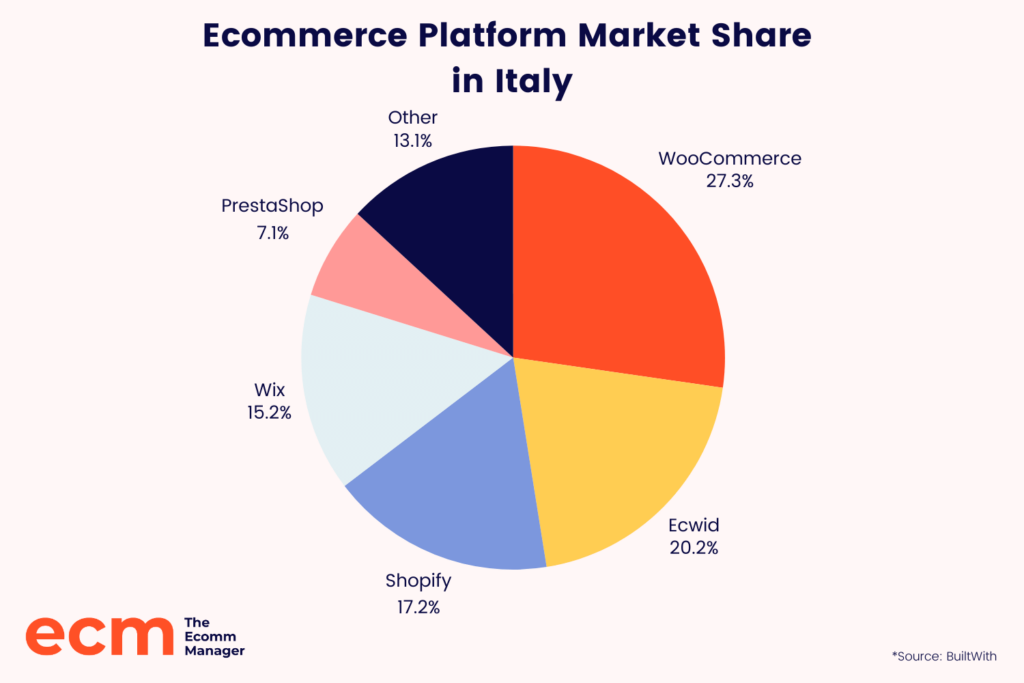
| Platform | Market Share (%) |
| WooCommerce | 27% |
| Ecwid | 20% |
| Shopify | 17% |
| Wix | 15% |
| PrestaShop | 7% |
| Other | 13% |
Netherlands
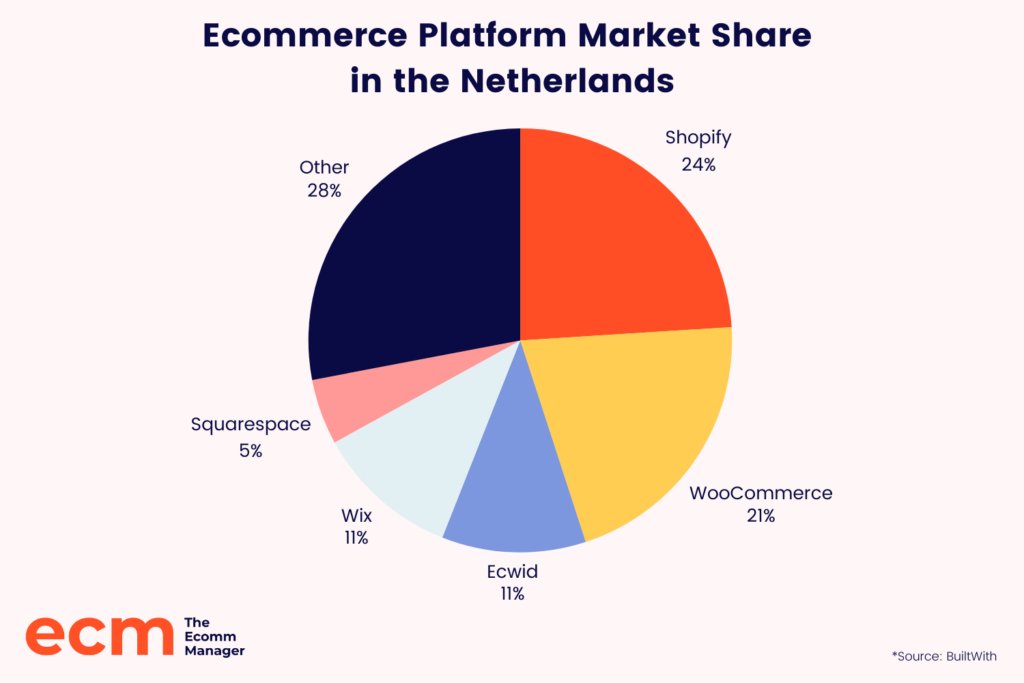
| Platform | Market Share (%) |
| Shopify | 24% |
| WooCommerce | 21% |
| Ecwid | 11% |
| Wix | 11% |
| Squarespace | 5% |
| Other | 28% |
Spain
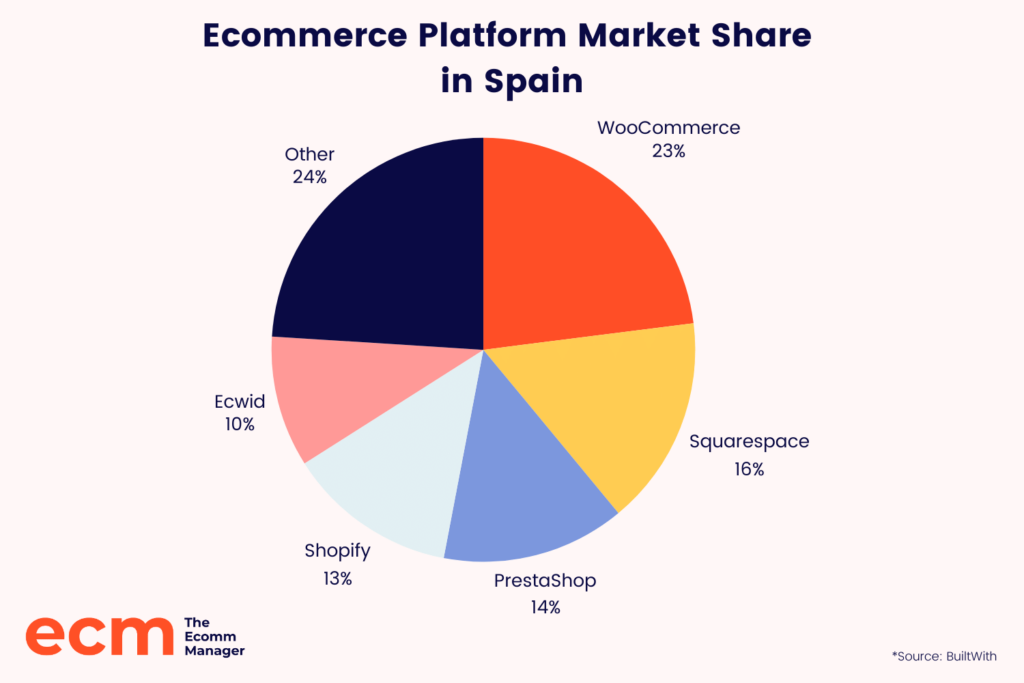
| Platform | Market Share (%) |
| WooCommerce | 23% |
| Squarespace | 16% |
| PrestaShop | 14% |
| Shopify | 13% |
| Ecwid | 10% |
| Other | 24% |
Russia
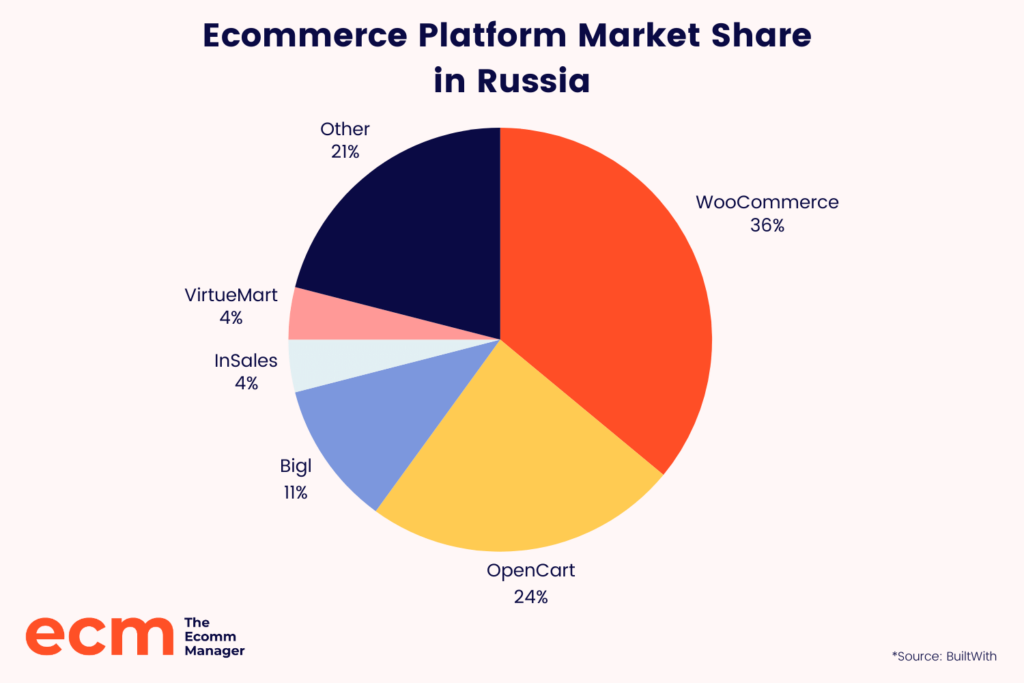
| Platform | Market Share (%) |
| WooCommerce | 36% |
| OpenCart | 24% |
| Bigl | 11% |
| InSales | 4% |
| VirtueMart | 4% |
| Other | 21% |
China
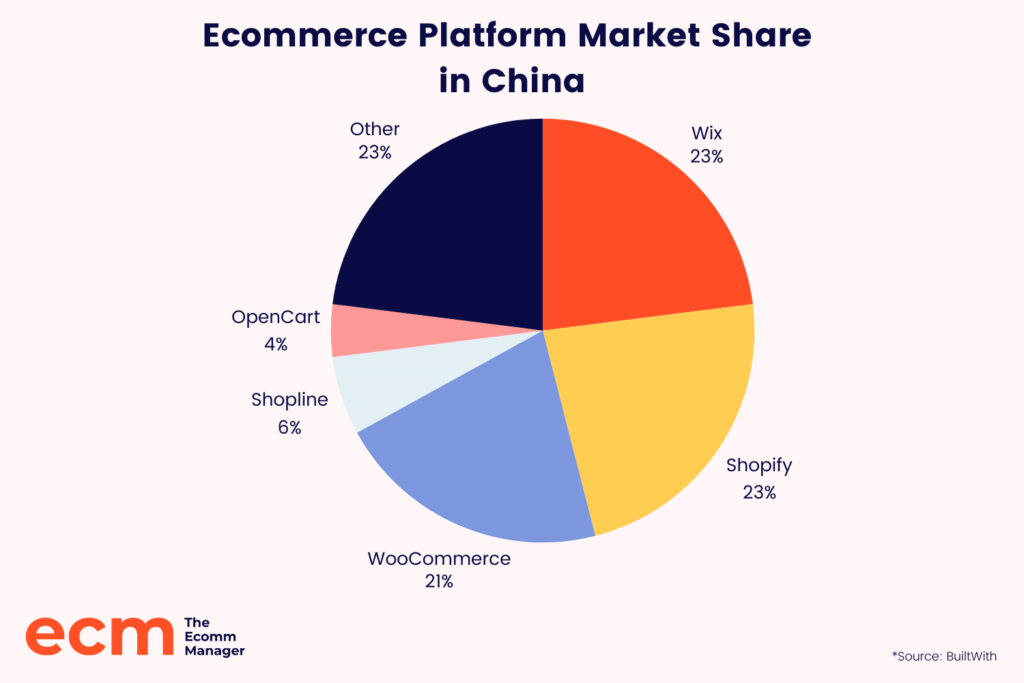
| Platform | Market Share (%) |
| Wix | 23% |
| Shopify | 23% |
| WooCommerce | 21% |
| Shopline | 6% |
| OpenCart | 4% |
| Other | 23% |
This changes the landscape quite a bit, and to a certain degree vindicates my American view of the ecommerce platform market.
In the English-speaking countries, Wix and Squarespace actually do represent a significant share of the market. But, globally, they seem to fall off the main arena.
Wix is actually topping the charts in a few countries—China, France, Japan—which I didn’t expect.
Plus, WooCommerce retains dominance in many markets where Shopify obviously hasn’t spent enough marketing dollars.
Not shown above is the most used platform in the general EMEA (Europe, Middle East, and Africa) region, which is Adobe Commerce (Magento), according to Statista.
Like with WooCommerce, Magento is obviously maintaining dominance in markets outside the US and UK.
Our Favorite Ecommerce Platforms
Now that you’ve seen the regional affinities for the various ecommerce platforms, we’ll give you a peek at what we think is best for various types of ecommerce brands.
You can find our more in-depth thoughts in our guide to the best ecommerce platforms, but here’s our top ten picks:
Ecommerce Platform Trends and Predictions
Obviously, things could change a lot in the next 5-10 years, as it has in the previous decade.
To get a sense of the shift in the last decade (plus some), take a look at this Google Trends chart (for the US):

You can see Shopify’s sure and steady rise, as Magento and WooCommerce have maintained roughly the same popularity over the years.
While both Wix and Squarespace aren’t ecommerce-first platforms, you can see their concurrent rise in popularity, as well.
The other platforms wouldn’t really show up on this chart, but let’s look at BuiltWith’s charts showing how each platform has trended over the years:
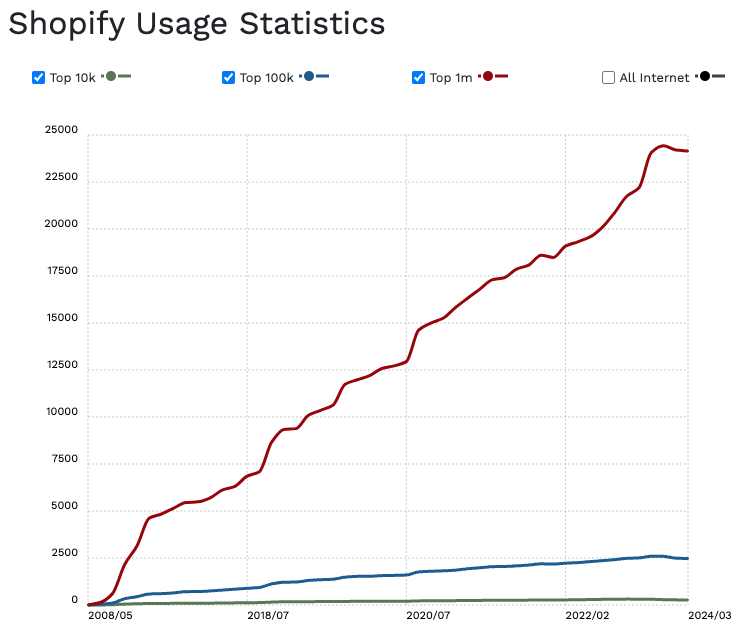
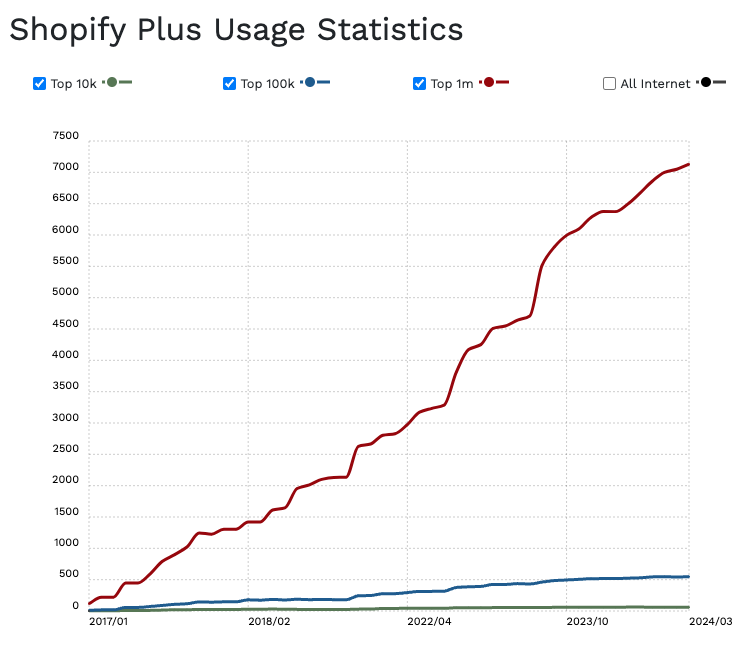

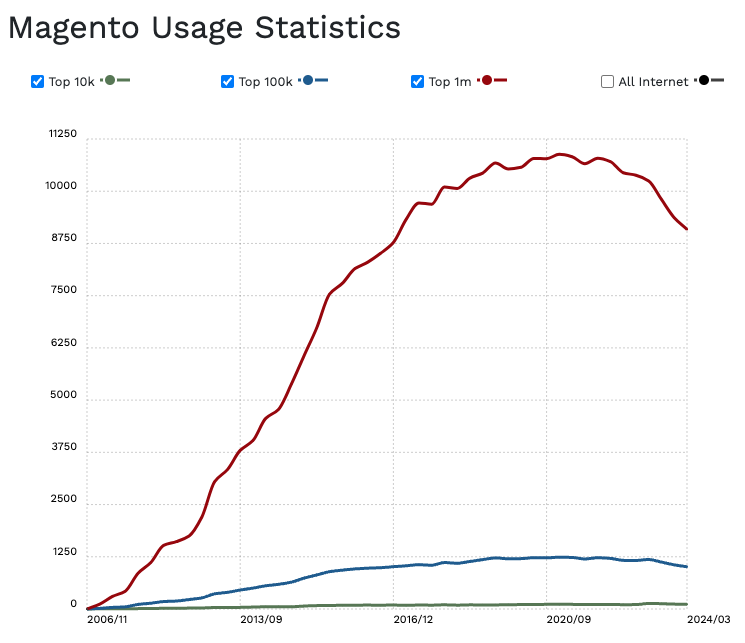
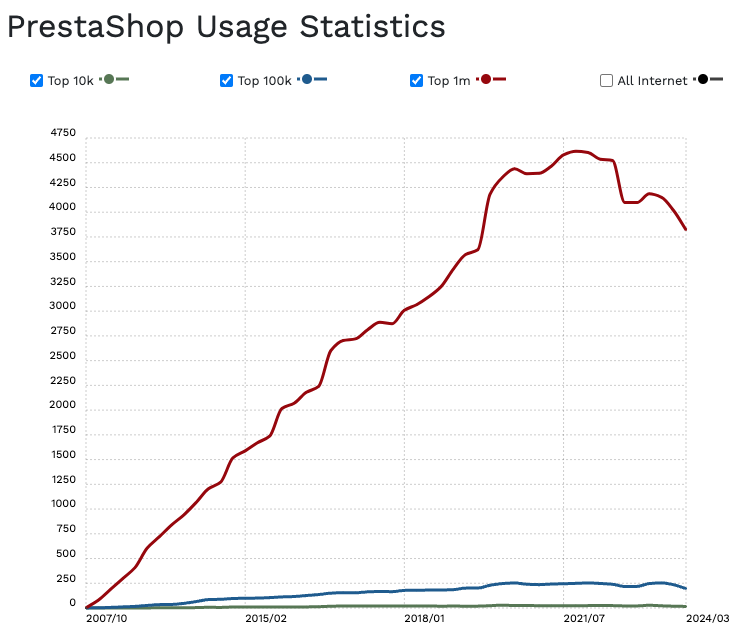

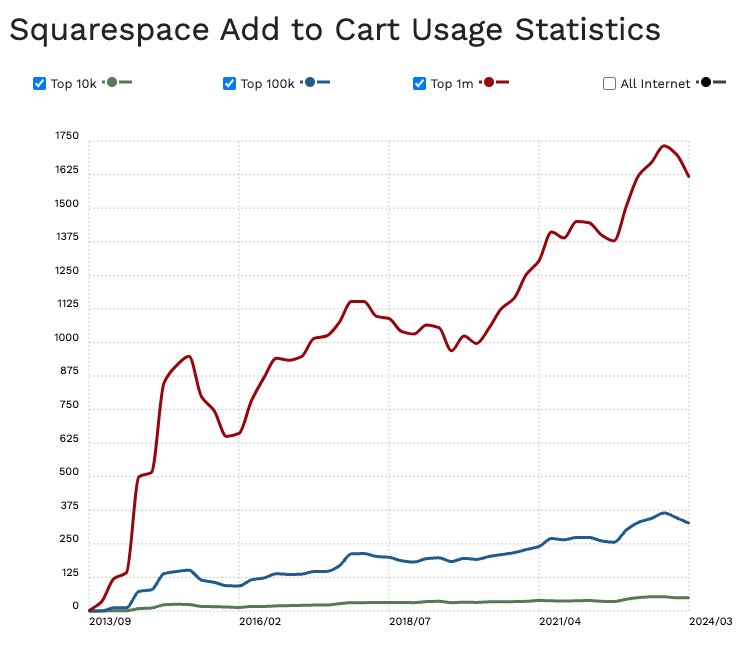
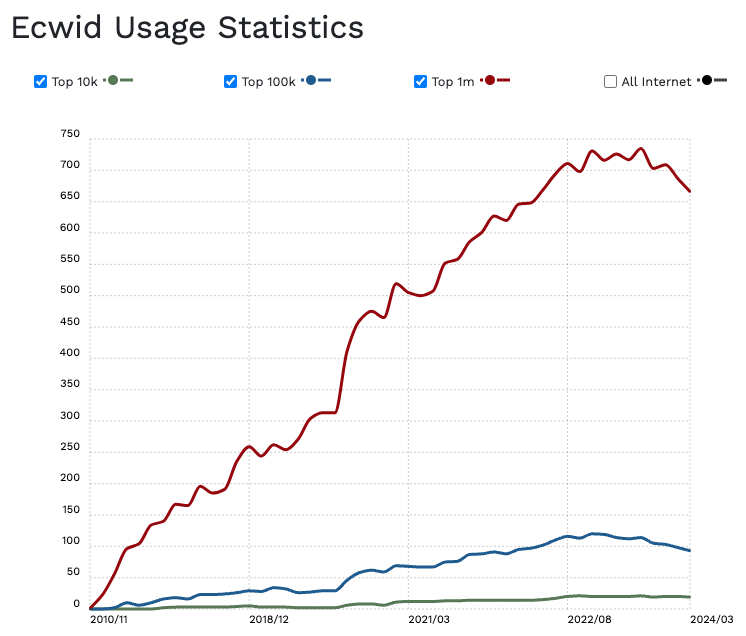
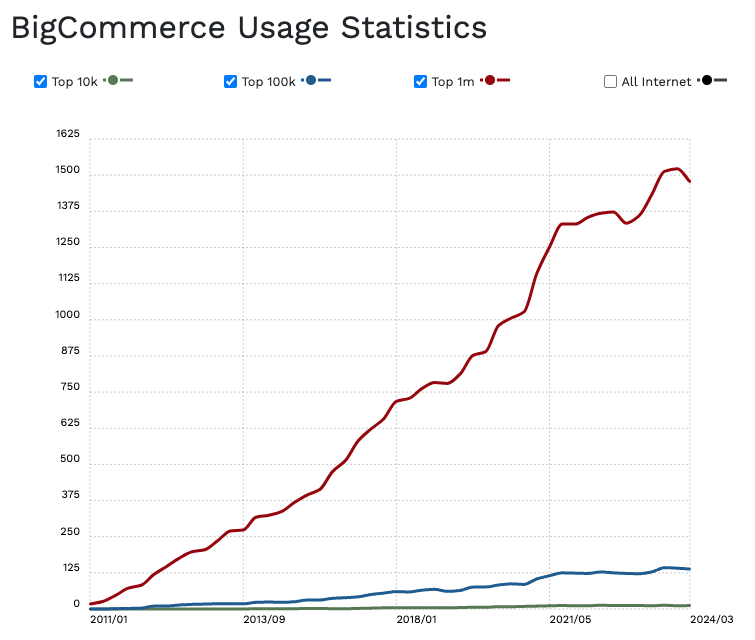
These trends are driven by technological shifts.
Where Amplience found its foothold with the enterprise interest in headless commerce, Shopify grew its share of the market by being the one-stop shop for creating your own shop.
Here are the trends that are changing the future of ecommerce platform market share numbers:
- Generative AI:
- Personalized shopping experiences: Generative AI will enable more personalized shopping experiences by predicting customer preferences and tailoring product recommendations.
- Chatbots and virtual assistants: AI-powered chatbots and virtual assistants can provide instant customer support and assistance, enhancing the customer service experience. Shopify is already kicking this off with Sidekick.
- Content creation: Generative AI can automate content creation, such as product descriptions and marketing materials, allowing businesses to scale their content efforts more efficiently. You can now find this in multiple platforms.
- Augmented reality (AR):
- Virtual try-ons: AR enables customers to virtually try on products such as clothing, accessories, and makeup, reducing the uncertainty of online shopping and decreasing return rates.
- Interactive product displays: AR can create interactive product displays that allow customers to visualize how products will look in their environment, such as furniture in their homes.
- Headless commerce:
- Flexibility and customization: Headless commerce decouples the front-end and back-end of ecommerce platforms, allowing businesses to create highly customized and flexible shopping experiences. This approach is gaining popularity among enterprises looking for tailored solutions.
- Omnichannel integration: With headless commerce, businesses can seamlessly integrate multiple channels (e.g., mobile, web, social media) to provide a consistent and unified customer experience.
- Global expansion and localization:
- Cross-border ecommerce: As ecommerce continues to expand globally, platforms that support cross-border transactions and localization (e.g., language, currency, and regional regulations) will have a competitive advantage.
- Localized marketing strategies: Tailoring marketing strategies to local cultures and preferences can help businesses capture new markets and grow their customer base.
Ecommerce is always changing, so platforms have to adapt and stay on the forefront of technology to stay on top or rise to the top. Who’s the next Shopify? Time will tell.
Final Thoughts
If you’re in the market for an ecommerce platform, you are both in luck and in for a difficult decision.
We’re lucky to have so many to choose from these days, but that brings with it decision paralysis.
In our guide to choosing an ecommerce platform, we don’t pretend it’ll be easy (and we even give you some homework), but doing the work to find what’s best for your brand pays off big in the long run.
We’ve certainly got our own opinions on the matter, as you can tell from our multiple best of ecommerce platform guides:
- SaaS Ecommerce Platforms
- B2B Ecommerce Platforms
- Ecommerce Marketplace Platforms
- Subscription Ecommerce Platforms
- Ecommerce Platforms For Small Businesses
- Headless Ecommerce Platforms
- Omnichannel Commerce Platforms
- Enterprise Ecommerce Platforms
- Open Source Ecommerce Platforms
But, ultimately, the choice depends on you. Hopefully, showcasing what the most popular ecommerce platforms in the world are can give you some extra detail to make your choice.
For more helpful ecommerce tips and software suggestions, sign up for The Ecomm Manager newsletter today!




